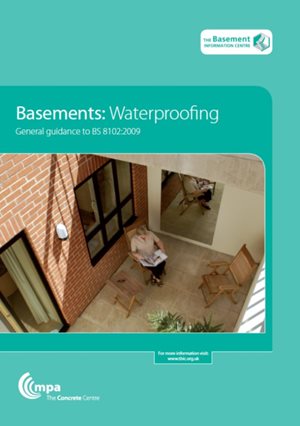Types of waterproofing
There are three main methods of providing protection against ground water for residential basements. These are defined in BS 8102 as Type A (Barrier) system, Type B (Structurally Integral) system and Type C (Drained) system. Their application is influenced by the ground conditions and proposed building use. The definition of terms and guidance related to their appropriate usage, are highlighted in the 2009 revision of BS 8102.
Alternative approaches
The traditional method of waterproofing domestic basements in Britain was a single barrier method (Type A) or drained protection (Type C). Earlier materials used in basement construction have since been developed into more durable waterproofing membranes.
Further alternative approaches have been developed, whereby hydrostatic pressure on the wall structure is eliminated. These methods incorporate a drainage blanket around the perimeter of the basement, allied to effective drainage below the floor slab and around the building. Suitability depends on the drainage characteristics of the ground and topography.
A combination of systems can also be an appropriate design solution. For example, the application of additional waterproofing systems to a Type B structure will improve water vapour control or provide further protection against water ingress.
Each of these methods is viable for domestic basements in Britain, depending upon the specifier’s preference, site conditions, the type of development and perceived risk. The table below provides a summary of appropriate waterproofing protection for varying risks associated with water table levels and useful additional measures to reduce risk dependant on project particulars. BS 8102 should be consulted for further details.
Risk associated
with water table |
Water table classification
(see notes) |
Type A (Barrier) |
Type B (Structurally Integral) |
Type C (Drained) |
| Piled Wall |
Reinforced Concrete wall to Eurocode wall |
| Low |
Low |
Acceptable |
Acceptable |
Acceptable |
Acceptable |
| |
Variable |
Acceptable if 'variable' classification is due to surface water: seek manufacturer's advice |
Acceptable where:
a) the piled wall is directly accessible for repair and maintenance from inside the structure
or
b) the piled wall is combined with a fully bonded waterproofing membrane
or
c) the piled wall is faced internally with a concrete wall to Eurocode 2
|
Acceptable |
Acceptable |
| High |
High |
Acceptable where:
a) an appropriate cementitious multi-coat render or cementitious coating is used
or
b) the wall is of concrete to Eurocode 2
|
Acceptable |
Acceptable |
| Measures to reduce risk |
See waterproofing guide |
|
Notes:
Low: Where the water table is assessed to be permanantly below the underside of the base slab.
High: Where the water table is assessed to be permanantly above the underside of the base slab.
Variable: Where the water table fluctuates.
Soil permeability may affect risk under a low and variable water table.
|
More info
Related links

This guide provides general guidance on waterproofing solutions to BS 8102:2009 – the code of practice for protection of below-ground structures against water from the ground. The guidance is focussed on basements for dwellings, but can also be of use for deeper/larger basements.
By selecting "Download", you will be redirected to the Concrete Centre bookshop, where your order will be fulfilled.
Relevant members